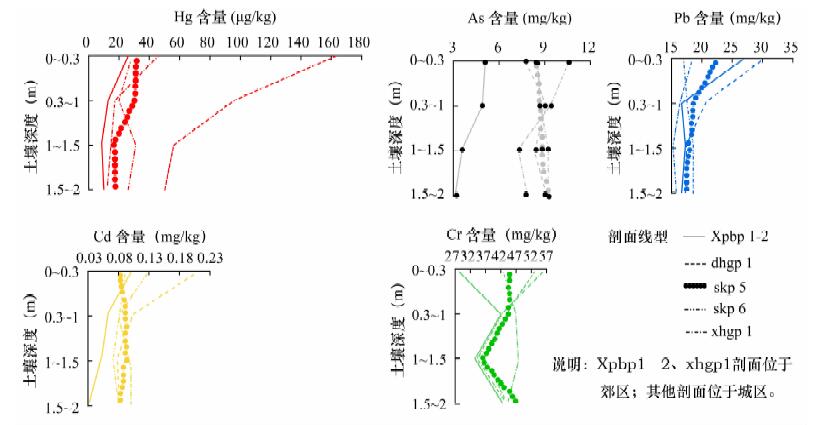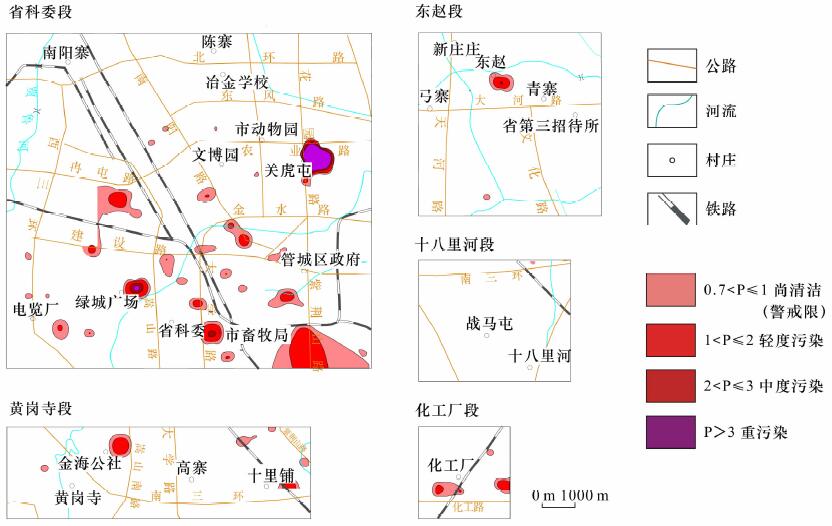Investigation and Evaluation of Heavy Metal Pollution in Soil from Zhengzhou City
-
摘要: 本文采用电感耦合等离子体质谱、原子荧光光谱法对郑州市及周边地区化探扫面(1 : 10万)采集的1014个表层土壤样品进行分析, 结合单因子污染指数法、内梅罗指数法评价了土壤中重金属含量水平、形态特征和污染分布状况。结果表明, 8种重金属的平均含量都低于《土壤环境质量标准》Ⅰ类土壤的临界值; 从地表到深部重金属元素含量逐步降低; 在测区1000 km2范围内, 一级、二级、三级土壤面积分别占89.6%、9.4%、1.0%, 土壤质量总体良好。在极个别中、重度污染区, 重金属主要以难以迁移和被植物利用的残渣态、铁锰氧化态形式存在, 目前对人及环境的实际危害很小。
-
关键词:
- 土壤质量 /
- 重金属污染评价 /
- 电感耦合等离子体质谱法 /
- 原子荧光光谱法
Abstract: The heavy metal contents of 1014 surface soil samples from a geochemical survey (1:100000) in Zhengzhou city and its surrounding areas has been determined by Inductively Coupled Plasma-Mass Spectrometry (ICP-MS) and Atomic Fluorescence Spectrometry (AFS). The single-factor index method and Nemerow index method were also used to evaluate the content level and morphological characteristics of heavy metals, and the distribution of their pollution. Analytical results show that the average contents of eight types of heavy metals are below the critical value of soil category I in the environmental quality standard for soils and the content of heavy metals decreases from the surface to the deep soil. In the 1000 km2 testing area, first-class, second-class and third-class soils account for 89.6%, 9.4%, and 1.0%, respectively, indicating good soil quality. In a few moderately and strongly polluted areas, heavy metals exist in the forms of a residual, ferri-manganese oxidation state, which were hard to migrate or use by plants and thus are not harmful to people and the environment. -
土壤重金属调查与评价的规范很多,例如《土壤地球化学测量规范》(DZ/T 0145—1994)、《多目标区域地球化学勘查规范》(DD2005-01)、《城市环境地质调查评价规范》(DD2008-03)、《土壤环境监测技术规范》(HJ/T 166—2004) 等,但由于行业及研究目的不同而各有侧重。马逸麟等[1]依据《多目标区域地球化学勘查规范》研究了江西省鄱阳湖及周边经济区土壤有机碳储量分布特征,计算出各土壤层的有机碳密度和储量。李玲等[2]对郑州市郊区土壤重金属元素Pb、Cr、Cd、Hg、As污染情况进行了评价分析,各种重金属均有超过背景值现象,其中Cr为重度污染,Pb为轻污染,其他重金属处于警戒线等级。河南省地质调查院在1991~1992年开展的“1:50万郑州—漯河一带土壤地球化学调查”和2004年~2008年完成的“河南省黄淮平原经济区农业地质调查”,结果都显示区内有Hg、Cr、Cd高背景区。
城市土壤重金属调查与评价是建设生态城市的前提和基础之一,理想的调查评价结果应该包括测区土壤中重金属的分布状况、在水平和垂向上的迁移规律、赋存形态及准确的污染评价。本文以郑州市及周边地区为研究区域,采用电感耦合等离子体质谱(ICP-MS)、原子荧光光谱(AFS)等技术对郑州市及周边地区化探扫面(1:10万)采集的1014个表层土壤样品进行分析,结合单因子污染指数法、内梅罗指数法评价土壤中8种重金属(As、Hg、Cd、Cr、Pb、Cu、Zn、Ni)的含量水平、形态特征和污染分布状况,为生态环境综合治理提供了实用价值的基础资料。
1. 样品采集与研究方法
1.1 样品采集
样品采集主要以《土壤地球化学测量规范》为依据,参考《土壤环境监测技术规范》内容,采用网格法采集样品。1:10万土壤化探按1 km×1 km的网度采样,每个样品由相距约300 m的3个子样组成,采样深度为20 cm,采样密度平均为1个/km2,共采集样品1014个。1:5万土壤化探在500 m×250 m的矩形网格的节点上取样,采样深度为20 cm,采样密度平均为8个/km2,共采集样品1006个。T型化探剖面测量的水平点距为20 m,垂直剖面的点距按0~30 cm、30~100 cm、100~150 cm、150~200 cm间隔连续取样,共采集样品120个。形态、价态分析样品共采集样品29个。
1.2 样品加工、分析方法及质量监控
8种重金属全量分析样品的加工流程:将原始样品在自然通风的环境下晾干,捡掉砾石、木屑等,用木棒压碎,过60目筛,然后缩分,取120 g装袋。用氢氟酸-盐酸-高氯酸-硫酸溶解样品,稀逆王水复溶残渣,3%硝酸定容,ICP-MS测定镉、铬、铅、铜、锌、镍。用氢氟酸-硝酸-高氯酸溶解样品,20%盐酸定容,氢化物发生原子荧光光谱法(HG-AFS)测定砷、汞。
重金属形态、价态分析样品的加工流程:将原始样品在自然通风环境下晾干,捡掉砾石、木屑等,用木棒压碎,过20目筛,经室温风干混匀后缩分取土壤试样200 g,采用玛瑙无污染样品制备机具将样品粉碎至100目装袋。取定量样品,分别以水、氯化镁、醋酸钠、焦磷酸钠、盐酸羟胺、过氧化氢为提取剂提取水溶态、离子交换态、碳酸盐结合态、腐植酸结合态、铁锰氧化物结合态、有机结合态,制备各形态分析液。上述提取各形态后的残渣用盐酸、硝酸、高氯酸、氢氟酸处理后制备残留态分析液。用电感耦合等离子体发射光谱法(ICP-OES)分析各相态中的铜、铅、锌、镍、镉、铬,用HG-AFS法分析砷、汞。
分析过程中,按每50个样品为1批,每一个分析批次中各均匀插入4个国家一级或省级标准物质,对分析准确度进行控制,合格率均为100%;按送样总数的5%抽取检查样品,编成密码作为检查样进行分析,控制结果精密度,8个元素的内检合格率全部大于95%;8个元素中除Cd的报出率最低为99.7%之外,其余7个元素的报出率均为100%。
1.3 土壤质量评价方法
土壤重金属污染评价方法[3, 4]有多种,本次采用单因子污染指数法、内梅罗指数法,对郑州市土壤环境质量进行评价。
1.3.1 单因子污染指数法计算方法及分级标准
单因子污染指数法是以土壤元素背景值为评价标准来评价重金属元素的累积污染程度,表达式为:

式中:Pi—土壤中重金属元素i的环境质量指数;Ci—重金属元素i的实测浓度;Si—重金属元素i的土壤环境质量标准(GB15618—1995) 中Ⅱ类土壤(pH值为6.5~7.5) 中重金属元素i的临界值(mg/kg):Cd 0.6,Hg 0.5,As 25,Cu 100,Pb 300,Zn 250,Cr 120,Ni 50。
根据土壤单因子污染指数值,把土壤质量分为5个级别:Ⅰ级(无污染),Pi≤1;Ⅱ级(轻微污染),1<Pi≤2;Ⅲ级(轻度污染),2<Pi≤3;Ⅳ级(中度污染),3<Pi≤5;Ⅴ级(重度污染),Pi>5。
1.3.2 内梅罗指数法计算方法及分级标准
内梅罗指数反映了各污染物对土壤的作用,同时突出了高含量污染物对土壤质量的影响。土壤综合污染指数(P综合)计算公式为:

式中:Pi均—土壤中各污染物的指数平均值;Pi最大—土壤中单项污染物的最大污染指数。
根据内梅罗指数值,把土壤质量分为5个级别:Ⅰ级(清洁),P综合≤0.7;Ⅱ级(尚清洁),0.7<P综合≤1.0;Ⅲ级(轻度污染),1<P综合≤2.0;Ⅳ级(中度污染),2<P综合≤3.0;Ⅴ级(重度污染),P综合>3。
2. 郑州土壤重金属分布特征和污染状况
2.1 重金属区域分布特征
用1:10万土壤化探采集的1014个土壤样品,统计出全区地球化学元素特征值。As、Hg、Cr、Ni、Cu、Zn、Cd、Pb的含量范围(mg/kg)依次为:5.10~20、14~821.30(μg/kg)、28.73~205.67、9.46~28.52、9.01~28.11、29.94~113.23、0.05~1.14、15~206.78,均值(mg/kg)依次为:8.97、56.13(μg/kg)、52.11、52.11、17.64、63.43、0.14、24.51,变异系数依次为:17%、110%、22%、18%、17%、18%、42%、38%,异常样品的个数依次为38、52、49、68、51、53、56、51个。
就均值而言,8种重金属含量都低于《土壤环境质量标准》中Ⅰ类土壤的临界值,说明研究区内土壤质量总体良好,从异常个数看,存在点或面的浓集现象。郑州市土壤中重金属的高背景值主要沿京广铁路两侧展布,并且显示多种重金属叠加。尤其是老城区,数值高,分布面积大。由于工作区地层为第四系的洪积物、冲积物、风积物,所以不可能是成矿作用形成,推断主要为生活和火车废物、废气、废水所致。
在1:10万土壤地球化学测量的基础上,选择5个异常区进行1:5万土壤化探异常查证,地球化学元素特征值见表 1。与1:10万土壤统计的地球化学元素特征值相比,在异常区内重金属含量范围明显变大,变异系数最低的也有1636%,省科委段Hg的变异系数高达63715%。在省科委段,7种重金属(As、Hg、Cd、Cr、Cu、Zn、Ni)最高值为Ⅱ类土壤临界值的1~60倍,尤其是Hg达60多倍,Hg、Cd、Cr、As是污染的主要因子,面积大、强度高,本区位于郑州市城区中心地带,密集分布着行政、商业、居民区等,推断城市人类活动所致。在化工厂段,Cu、Cd最高值分别为Ⅱ类土壤临界值的2.6倍和1.6倍,Hg、Ni、Zn为1~1.5倍,本区为化工厂旧址,推断为原化工厂生产所致。黄岗寺段的Hg、Cr、Cu、Cd、Pb大于Ⅱ类土壤临界值,东赵的Cd、十八里河段的Cd、Hg大于Ⅱ类土壤临界值,这些区段主要分布着农田及居民区,推断为人类生活、农耕所致。
表 1 异常区地球化学元素特征值Table 1. The contents of soil pollutants in anomaly area采样
区段样品
个数项目 As Hg Cr Ni Cu Zn Cd Pb 省科委 577 范围(mg/kg) 4.71~40.31 14.65~32885.79 28.31~197.37 10.46~88.5 10.02~153.55 33.04~449.82 0.016~1.186 15.97~219 均值(mg/kg) 8.75 218.20 56.44 19.87 24.10 89.55 0.18 29.87 标准偏差
(mg/kg)2.22 1390.24 15.09 4.77 11.34 40.88 0.14 17.14 变异系数 25.42 637.15 26.74 24.01 47.06 45.65 73.99 57.38 化工厂 71 范围(mg/kg) 5.77~13.09 15.15~759.6 32.65~94.5 14.63~79.27 11.09~262.7 38.65~387.5 0.06~0.964 15.83~140.7 均值(mg/kg) 9.67 65.16 61.22 22.26 23.54 73.63 0.17 27.83 标准偏差
(mg/kg)1.39 106.69 15.02 7.55 29.58 46.08 0.14 17.11 变异系数 14.40 163.73 24.53 33.90 125.70 62.58 84.61 61.47 东赵 150 范围(mg/kg) 3.49~19.02 14.73~21.83 37.17~2.47 15.2~163.07 13.04~67.42 38.12~240 0.035~0.754 14.63~34.2 均值(mg/kg) 9.62 56.62 59.44 24.13 23.65 76.56 0.14 21.65 标准偏差
(mg/kg)2.55 44.81 16.35 12.25 7.86 30.16 0.09 3.77 变异系数 26.48 79.13 27.50 50.76 33.22 39.39 66.12 17.40 黄岗寺 205 范围(mg/kg) 4.87~12.86 5.32~1233.12 27.2~148.8 10.74~43.54 11.44~133.02 39.1~180.72 0.047~1.798 15.35~364.9 均值(mg/kg) 8.73 72.87 51.54 19.23 19.68 66.34 0.14 28.82 标准偏差
(mg/kg)1.43 114.25 12.39 2.86 9.27 18.60 0.15 38.64 变异系数 16.36 156.80 24.05 14.88 47.11 28.03 103.43 134.09 十八里河 102 范围(mg/kg) 2.72~13.76 15.4~462.22 32.4~91.3 11.6~28.87 10.38~62.46 40.71~180.86 0.026~0.612 15.67~70.31 均值(mg/kg) 7.40 57.69 50.09 17.74 17.58 74.01 0.10 24.67 标准偏差
(mg/kg)1.30 55.45 9.87 3.17 5.60 25.54 0.07 6.94 变异系数 17.61 96.12 19.71 17.88 31.84 34.51 68.37 28.15 注:Hg的数据单位为μg/kg。 2.2 重金属垂向分布特征
一般认为重金属不易随水淋滤,土壤微生物不能分解[5],常被土壤强烈吸附和固定,大多数在土壤表面残留、累积,不易向下层迁移,但是土壤受到重金属污染后,含重金属浓度较高的污染表土可以通过淋滤方式向地下迁移[6]。本研究在典型异常段布设T型剖面,采集深层土壤样品进行分析, 用各层次元素平均值绘制折线图见图 1。可以发现,从地表到深层重金属含量有下降趋势,说明污染源主要来自表层。As在城区内表层土壤中的含量普遍低于深层土壤,郊区则表现为表层高于深层,由此推测As与其他重金属相比更易在水中溶解,在城区随雨水和生活、工业用水的集中排放而下渗到深层土壤。其他重金属一般不易随水淋滤[7]而聚集在土壤表层。
2.3 重金属元素形态特征
重金属在土壤中的环境行为不完全取决于其总量,在一定程度更取决于其化学形态[7]。不同形态重金属,其活性、毒性及生态效应有较大差异[8],一般认为活性态在土壤中易被迁移和被生物吸收。
本次工作在1:5万及土壤剖面工作的基础上,采集了29件样品进行Cu、Zn、Ni、Pb、Cd的形态分析,结果显示各形态分量占全量的比例从大到小依次为:残渣态、铁锰氧化态、腐植酸结合态、碳酸盐结合态、强有机结合态、离子交换态、水溶态,前5种形态占比达95%以上,后2种形态占比不到5%,其中残渣态和铁锰氧化态占比达70%以上。残渣态重金属一般存在于硅酸盐、原生和次生矿物等土壤晶格中, 是自然地质风化过程的结果,铁锰氧化物结合态重金属一般是被铁锰氧化物吸附或共沉淀阴离子而成,在自然界正常条件下,这两种结合态重金属不易释放, 能长期稳定在沉积物中, 难以迁移并不易被植物吸收,说明工作区土壤中重金属的生物活性较差,对环境污染较低。
2.4 土壤重金属污染评价
利用5个异常查证区数据计算单因子污染指数、内梅罗综合污染指数,绘制内梅罗综合指数图(图 2)。省科委段的污染点多、面大,有连片的趋势,个别地段达中度、重度污染,污染元素以Hg、Cd、Zn、As为主。化工厂段为轻度污染,污染元素以Hg、Cd为主。黄岗寺段为轻度污染,污染元素以Cu、Cd、Hg为主。东赵段为轻度污染,污染元素以Ni、Cd为主。十八里河段无污染现象。
3. 土壤环境质量评价
根据《土壤环境质量标准》各类土壤临界值,以1:10万、1:5万土壤地球化学测量数据为基础,绘制郑州市及周边地区土壤质量分级图,用Mapgis软件计算各级土壤面积。结果显示在工作区1000 km2范围内,896 km2都是一级土壤,占比89.6%;94 km2为二级土壤,占比9.4%;10 km2为三级土壤,占比1.0%,表明土壤质量总体良好。
4. 结论
通过对郑州市及周边地区土壤中的重金属调查研究,结果显示工作区内土壤质量总体良好,在极个别中度、重度污染区,重金属集中分布在地表 30 cm之内,且主要以难以迁移和被植物利用的残渣态和铁锰氧化态形式存在,目前对人体及环境的实际危害很小。
本次研究一方面对污染区进行了层层浓缩、立体解剖,定位了污染层的空间分布;另一方面引入了形态分析,确定了污染物的赋存形态,评估了对环境危害的有效程度。该研究成果可为郑州城市发展规划提供详实的地化环境资料,对于后续的进一步研究及修复治理具有较强的实用意义。
-
表 1 异常区地球化学元素特征值
Table 1 The contents of soil pollutants in anomaly area
采样
区段样品
个数项目 As Hg Cr Ni Cu Zn Cd Pb 省科委 577 范围(mg/kg) 4.71~40.31 14.65~32885.79 28.31~197.37 10.46~88.5 10.02~153.55 33.04~449.82 0.016~1.186 15.97~219 均值(mg/kg) 8.75 218.20 56.44 19.87 24.10 89.55 0.18 29.87 标准偏差
(mg/kg)2.22 1390.24 15.09 4.77 11.34 40.88 0.14 17.14 变异系数 25.42 637.15 26.74 24.01 47.06 45.65 73.99 57.38 化工厂 71 范围(mg/kg) 5.77~13.09 15.15~759.6 32.65~94.5 14.63~79.27 11.09~262.7 38.65~387.5 0.06~0.964 15.83~140.7 均值(mg/kg) 9.67 65.16 61.22 22.26 23.54 73.63 0.17 27.83 标准偏差
(mg/kg)1.39 106.69 15.02 7.55 29.58 46.08 0.14 17.11 变异系数 14.40 163.73 24.53 33.90 125.70 62.58 84.61 61.47 东赵 150 范围(mg/kg) 3.49~19.02 14.73~21.83 37.17~2.47 15.2~163.07 13.04~67.42 38.12~240 0.035~0.754 14.63~34.2 均值(mg/kg) 9.62 56.62 59.44 24.13 23.65 76.56 0.14 21.65 标准偏差
(mg/kg)2.55 44.81 16.35 12.25 7.86 30.16 0.09 3.77 变异系数 26.48 79.13 27.50 50.76 33.22 39.39 66.12 17.40 黄岗寺 205 范围(mg/kg) 4.87~12.86 5.32~1233.12 27.2~148.8 10.74~43.54 11.44~133.02 39.1~180.72 0.047~1.798 15.35~364.9 均值(mg/kg) 8.73 72.87 51.54 19.23 19.68 66.34 0.14 28.82 标准偏差
(mg/kg)1.43 114.25 12.39 2.86 9.27 18.60 0.15 38.64 变异系数 16.36 156.80 24.05 14.88 47.11 28.03 103.43 134.09 十八里河 102 范围(mg/kg) 2.72~13.76 15.4~462.22 32.4~91.3 11.6~28.87 10.38~62.46 40.71~180.86 0.026~0.612 15.67~70.31 均值(mg/kg) 7.40 57.69 50.09 17.74 17.58 74.01 0.10 24.67 标准偏差
(mg/kg)1.30 55.45 9.87 3.17 5.60 25.54 0.07 6.94 变异系数 17.61 96.12 19.71 17.88 31.84 34.51 68.37 28.15 注:Hg的数据单位为μg/kg。 -
http://www.cnki.com.cn/Article/CJFDTOTAL-YKCS201402018.htm http://www.cnki.com.cn/Article/CJFDTOTAL-TRTB200805043.htm http://www.cnki.com.cn/Article/CJFDTOTAL-KCYD201102018.htm http://cdmd.cnki.com.cn/Article/CDMD-10364-2007152575.htm http://www.cnki.com.cn/Article/CJFDTOTAL-SYHH201004038.htm 刘剑锋, 谷宁, 张可慧.土壤重金属空间分异及迁移研究进展与展望[J].地理与地理信息科学, 2012, 28(2):99-102. Liu J F, Gu N, Zhang K H.Progress and Prospect of Soil Heavy Metal Spatial Differentiation and Migration[J].2012, 28(2):99-102.
http://www.cnki.com.cn/Article/CJFDTOTAL-TRYJ200904016.htm doi: 10.3321/j.issn:1000-4890.2005.12.025 -
期刊类型引用(10)
1. 刘修英,黄功学,高镜清,薛涛,郭朔泽. 贾鲁河郑州段沉积物中重金属污染特征和生态风险评价. 华北水利水电大学学报(自然科学版). 2022(04): 98-108 .  百度学术
百度学术
2. 马丽,郭学良,王浩蓓,王冰冰,张丽英,杨森,田文静. 商丘市不同建设用地分区土壤重金属污染特征及评价. 西北林学院学报. 2022(05): 80-87 .  百度学术
百度学术
3. 乔辛悦,刘璐,刘文霞,吴明作,张发文. 表层沉积物重金属生态风险评价——以郑州市东风渠为例. 工业技术创新. 2021(04): 137-141 .  百度学术
百度学术
4. 张珂,厉萌萌,刘德权,张寅栋,史家庆,杨进川,马闯. 郑州市周边小麦农田土壤中重金属分布特征与污染状况研究. 轻工学报. 2020(02): 50-58 .  百度学术
百度学术
5. 陈洪,高越,周志爽,付蓉,邵倩,李子君,占长林,张家泉,刘红霞,万的军. 武汉市不同功能区土壤重金属污染特征及健康风险评价. 湖北理工学院学报. 2019(03): 17-24 .  百度学术
百度学术
6. 田志仁,封雪,姜晓旭,李宗超,李妤,夏新. 生态环境监测工作中应用AAS/AFS和XRF法测定土壤重金属数据质量评价. 岩矿测试. 2019(05): 479-488 .  本站查看
本站查看
7. 高娟琴,于扬,王登红,刘丽君,王伟,郝雪峰,代鸿章. 川西甲基卡锂资源富集区根系土壤重金属含量水平及时空分布特征. 岩矿测试. 2019(06): 681-692 .  本站查看
本站查看
8. 肖凡,张宁,姜云军,郭秀平,王趁荣,刘璐. 密闭酸溶-电感耦合等离子体原子发射光谱法测定地球化学调查样品中硼. 冶金分析. 2018(06): 50-54 .  百度学术
百度学术
9. 谷阳光,高富代. 我国省会城市土壤重金属含量分布与健康风险评价. 环境化学. 2017(01): 62-71 .  百度学术
百度学术
10. 马文娟,王录军,杨玉娜. 我国部分城市土壤和降尘重金属污染现状与研究展望(英文). Agricultural Science & Technology. 2017(12): 2440-2445+2449 .  百度学术
百度学术
其他类型引用(3)



 下载:
下载:


 京公网安备 11010202008159号
京公网安备 11010202008159号